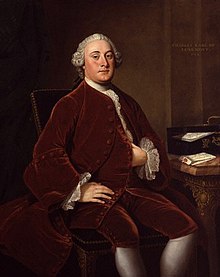Charles Wyndham, 2nd Earl of Egremont
Charles Wyndham, 2nd Earl of Egremont (born August 19, 1710 - August 21, 1763 in London ) was a British peer and politician.
Life
Charles Wyndham was the eldest son of William Wyndham, 3rd Baronet and his first wife Catherine Seymour , daughter of Charles Seymour, 6th Duke of Somerset . His younger brother was Percy Wyndham , who later became Earl of Thomond. From 1719 Charles Wyndham attended Westminster School , then from 1725 he studied at Christ Church College in Oxford. From 1728 to 1730 he went on a grand tour of Germany, France and Italy with George Lyttelton and Henry Bathurst . After a failed candidacy in 1734, he became a member of the House of Commons in 1735 , first for Bridgwater , and until 1750 for Appleby and Taunton . Politically, like his father, he belonged to the Tories who were in opposition to the Whig government. After the death of his father in 1740 he inherited his property and the title of 4th Baronet , of Orchard. Politically, however, he increasingly approached the Whigs until he inherited the title of Earl of Egremont in 1750 after the death of his uncle, the Dukes of Somerset . From March 22, 1751 he was a member of the House of Lords , from 1751 to 1759 he held the office of Lord Lieutenant of Cumberland . His political career reached its climax when he became a member of the Privy Council in July 1761 and became Secretary of State for the Southern Department and thus British Foreign Secretary under Prime Minister Duke of Newcastle in October 1761, succeeding William Pitt . He kept this office under Prime Minister Bute , and in 1762 he became Lord Lieutenant of Sussex . On April 16, 1763, his brother-in-law George Grenville , the husband of his sister Elizabeth Wyndham , became Prime Minister. Wyndham as Foreign Minister and Grenville as Prime Minister formed a triumvirate , together with George Montagu-Dunk, 2nd Earl of Halifax as Secretary of State for the Northern Department , which was broken up by Wyndham's untimely death in August 1763.
Wyndham became a minister with no prior diplomatic or administrative experience. One of the foundations of his foreign policy was the opposition to the Bourbon monarchies in France and Spain. As Foreign Minister he declared war on Spain in 1761 and concluded the Paris Peace with France and Spain in 1763 . In addition, he became involved in the North Briton affair of John Wilkes in 1763 . An immoderate eater, he suffered a stroke on August 21, 1763 , of which he died on the same day.
Wyndham as an art collector
According to his notes, he acquired a painting by Hogarth around 1734 . His father's inheritance enabled him to acquire further paintings and works of art, and from 1742 he was a member of the Society of Dilettanti . His uncle Algernon Seymour inherited extensive estates in Cumberland and Sussex. However, he neglected his estates in the north and lived mainly in Petworth House in Sussex, where he had the park redesigned by Capability Brown from 1751 . His rich legacy enabled him to build up an important art collection, with his taste in art influenced by Thomas Coke, 1st Earl of Leicester . From him he also took over the builder Matthew Brettingham , who built his new town house in London, Cambridge House in the borough of Westminster , and from 1754 to 1763 added his own museum space, today's North Gallery , in Petworth House . Since 1755 Wyndham, with the help of Matthew Brettingham the Younger , built up an important collection of ancient sculptures, which can still be seen in Petworth House today.In addition, from 1749 until his death alone, he acquired 183 paintings, including those by David Teniers the Younger and by Sébastien Bourdon , which are also still in Petworth House today. However, much of his painting collection was sold by his son in 1794.
Family and offspring
He married Alicia Maria Carpenter on March 12, 1751 , daughter of the Irish Baron George Carpenter, 2nd Baron of Carpenter of Killaghy . The couple had four sons and three daughters, including
- George Wyndham, 3rd Earl of Egremont (1751-1837)
- Elizabeth Alicia Maria Wyndham (1752-1826)
- Frances Wyndham (1755-1795)
- Percy Charles Wyndham (1757-1833)
- Charles William Wyndham (1760-1828)
- William Frederick Wyndham (1763-1828)
literature
- Lionel Henry Cust: Wyndham, Charles . In: Sidney Lee (Ed.): Dictionary of National Biography . Volume 63: Wordsworth - Zuylestein. , MacMillan & Co, Smith, Elder & Co., New York City / London 1900, pp. 240 - 243 (English) ..
- Christopher Rowell: The 2nd Earl of Egremont . In: Petworth House . The National Trust, 1997, pp. 75-81.
- HM Scott: Wyndham, Charles, second earl of Egremont (1710-1763). In: Henry Colin Gray Matthew, Brian Harrison (Eds.): Oxford Dictionary of National Biography , from the earliest times to the year 2000 (ODNB). Volume 60: Wolmark – Zuylestein. Oxford University Press, Oxford 2004, ISBN 0-19-861410-1 , ( oxforddnb.com license required ), as of 2004
Web links
- History of Parliament online: Wyndham, Charles (1710-63), of Orchard Wyndham, Som.
- Cracroft's Peerage: Earl of Egremont
- Charles Wyndham, 2nd Earl of Egremont, on thepeerage.com , accessed September 11, 2016.
Remarks
- ^ Joachim Raeder : The ancient sculptures in Petworth House (West Sussex) . Zabern, Mainz 2000, ISBN 3-8053-2448-0 .
| personal data | |
|---|---|
| SURNAME | Wyndham, Charles, 2nd Earl of Egremont |
| BRIEF DESCRIPTION | British nobleman and politician |
| DATE OF BIRTH | August 19, 1710 |
| DATE OF DEATH | August 21, 1763 |
| Place of death | London |

